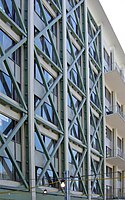
Photo from wikipedia
Capacity design, according to the modern seismic building codes, requires the application of specific rules and construction details in order to prevent brittle failure modes at material, element and structural… Click to show full abstract
Capacity design, according to the modern seismic building codes, requires the application of specific rules and construction details in order to prevent brittle failure modes at material, element and structural level. In particular, with reference to single-story precast reinforced concrete structures with columns joined by pinned beams, the Italian seismic building code, following the Eurocode 8 general principles, requires that beam-to-column connection should be designed in order to avoid the connection failure before the formation of the plastic hinge at the column base. However, no specific details are provided in order to reach such a performance. Recent European earthquakes showed that seismic performance of beam-to-column dowel connections can be very poor. Hence, for European typical dowel beam-to-column connections, this study aims to investigate: (a) possible connection configurations obtained according to seismic design; (b) possible failure modes involving connection elements (steel dowel, transversal steel reinforcement, dowel concrete cover); (c) how available formulations are able to describe such failure modes and the related shear strength; (d) influence of connection failure on the global seismic safety at collapse of new designed single-story RC precast buildings. The reference buildings and beam-to-column connections are designed considering different geometrical layouts of the primary structure and different seismic hazard levels, i.e. four sites and two soil types. Structural capacity is estimated considering global, i.e. related to column plastic hinge degradation measured in terms of top lateral displacements, and local, i.e. related to connection shear strength, failure modes. Nonlinear multi-stripe analyses are performed for the seismic assessment.
Journal Title: Bulletin of Earthquake Engineering
Year Published: 2020
Link to full text (if available)
Share on Social Media: Sign Up to like & get
recommendations!